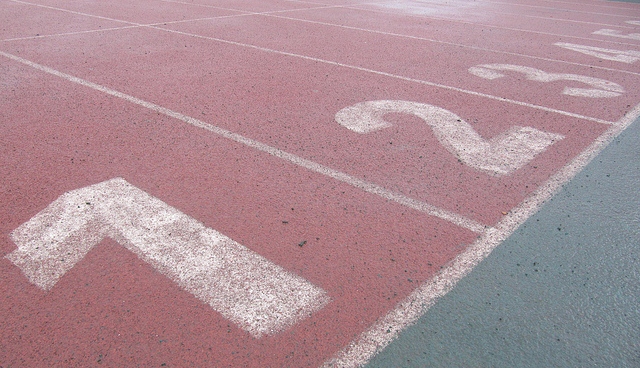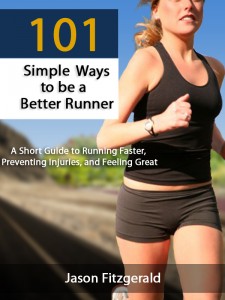Is there a way to get in better shape without running higher mileage or doing tougher workouts?

I think there is – and I’m about to show you how.
But first, before you get too excited, a few disclaimers:
- There are no shortcuts. To be a good runner and see consistent improvement, you have to put in a lot of hard work.
- I’m not suggesting performance-enhancing drugs. Duh.
- These strategies might mean the difference between a PR and an “almost PR” – but they’re the icing on the cake, not the meat of your actual training plan.
If you’re looking for those secret workouts or “top marathon tricks” then there are other websites for that. And you’ll never see the improvement that Strength Runners see – like Mark or Terry.
But for those who want to squeeze out every ounce of fitness from their bodies, there are certain ways to maximize training adaptations. Today, we’ll look at 5 specific strategies that you can start implementing this week.
These tips are excerpts from my book 101 Simple Ways to be a Better Runner, available for the Kindle or as an instant download. My goal is to give you a small sample of the 100+ pieces of advice in the book so you can make changes to your running for the better.
Learn to Love Negative Splits
Running a negative split simply means running the last half faster than the first. You should negative split most of your distance runs, workouts, and races if you can.
Negative splitting runs during training will increase your confidence to do it during a race – when time really counts. You also get a better aerobic stimulus (as in, more endurance!) when you teach your body to run faster later in a run when you’re already tired.
It’s easiest to do these types of workouts on out-and-back runs where you can time each half exactly. Any workout on the track lends itself well to negative splits since you can monitor each interval time to the second. Have fun with it!
Run Workouts That Have More Than Two Paces
Common workouts among runners include a set of intervals at a predetermined pace like your current 5k or half-marathon pace. There’s nothing inherently wrong with these workouts – in fact, they can be great during the specific phase of your training period.
But including 2-3 different paces in your workout can help you learn to run faster when tired, boost your fitness, and improve your finishing kick. So instead of your next 3 x mile at 10k pace, try the following:
2 x mile at your goal 10k pace with 3 minutes jog recovery, then 2 x 800m at your 5k pace with 2 minutes jog recovery.
This workout has you running at a faster pace at the end with the same overall volume. Hopefully this workout will help you negative split your 10k race!
Run Fasted Once in Awhile
Occasionally run in the morning without breakfast to practice running on low glycogen stores. A moderate effort in this state has been shown in studies to help you burn more fat instead of carbs and make you more efficient with your existing carbohydrate reserves.
This strategy is a bit advanced, so only experiment with it if you’re an experienced runner and training for a longer race like a half-marathon or marathon. A smart fueling strategy can help you achieve your goals in these long races and fasted runs can help.
Don’t Be Afraid to Run in the Heat and Humidity
Those brutal summer runs might be slow, hot, sweaty, and miserable, but they actually help you. See, your body learns to be more efficient when the temperature and humidity are really high. You lose less salt through your sweat and better regulate your body temperature. In fact, high heat training can actually simulate running at altitude.
Of course, I’m not recommending you give yourself heat stroke during 100 degree days in the middle of summer. But with 1-2 moderate runs every week in hot and humid conditions, you’ll improve your body’s metabolic efficiency. Just remember to hydrate!
Run Barefoot Strides (instead of plain ‘ole regular strides)
For more foot and lower leg strength, you can run some or all of your strides barefoot. Before you do, make sure that you have a good place to run them; you can’t do them anywhere.
Barefoot strides are best done on a well-manicured or synthetic turf field where you know the surface is smooth and free of small rocks, sticks, or glass. Start by doing 1-2 strides barefoot and then take a few days to see how your feet feel. The next time you can increase to 2-4 strides.
Running strides barefoot not only helps you develop lower leg strength, but you’re also improving your running economy and developing more efficient form. Win-win!
Once a Week, Run Something Random
Variety is the spice of life – and also the spice of a good training plan. Experiment with your program and explore a new trail, a hill workout instead of an interval workout, a fartlek instead of a tempo, or running with a friend.
Alternate your shoes with a pair of minimalist trainers. Run a few faster surges at the end of your long run or end your tempo uphill for once. These seemingly minor variations in your training keep you fresh both physically and mentally. They’ll also help you reduce injuries as you’re not stressing your body in the same few ways throughout your entire training cycle.
***
These training strategies are adapted from 101 Simple Ways to be a Better Runner: A Short Guide to Running Faster, Preventing Injuries, and Feeling Great.
It’s still a Top 25 Kindle best-seller in three categories, including a 4.7 average rating out of 5 stars. Thank you for making it such a big success! I’m very proud of how it’s doing and by the responses I’ve received:
“This book is the best resource about any question you might have about running.” – Tom
“With so much info out there it was nice to read tips on running that I thought I could actually apply to my own training as an average runner instead of reading about what super humans do to be super human runners. Definitely a book to keep for quick reference along side my training journal.” – Miley
“I have been a runner for many years and read a lot on the topic. Like all runners, I am always looking to improve! I have yet to find a refreshingly simple, easy-to-digest guide to improve as a runner until now.” – Mark
I’d love for you to check it out on Amazon here.
No Kindle? No problem! Just download it now as a PDF.